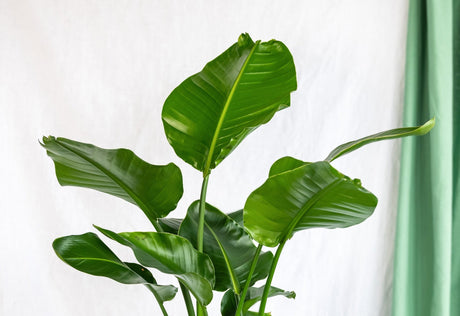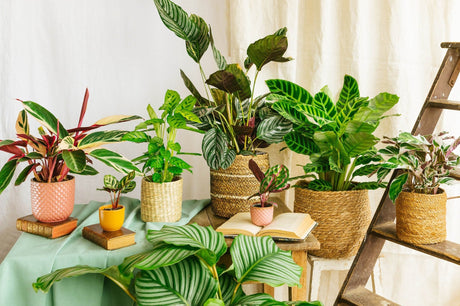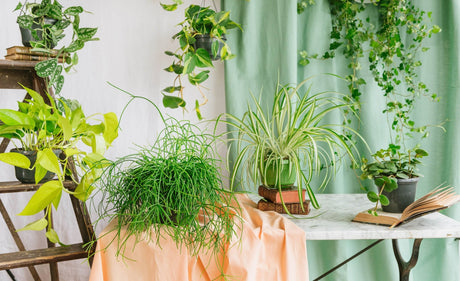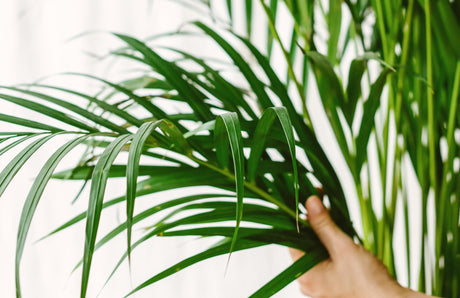This maintenance sheet is suitable for all Calatheas in general and more particularly for Calatheas: Orbifolia , Makoyana, Lancifolia, Leopardina, Ornata, Triostar, Zebrina, White Fusion, Medallion, Roseopicta.Calathea is a plant that has depolluting properties and is not dangerous for our four-legged friends. It is these characteristics, the beauty of its leaves and the diversity of the genus that have popularized this magnificent South American plant in our interiors.
How to take care of a Calathea?
Humidity:
It prefers a humidity level greater than 60%, ideally 80%. It is almost essential to its proper development, otherwise you will notice that its leaves wither, become damaged, or turn brown in an environment that is too dry.
It prefers a humidity level greater than 60%, ideally 80%. It is almost essential to its proper development, otherwise you will notice that its leaves wither, become damaged, or turn brown in an environment that is too dry.
Exposure:
The Calathea grows at the foot of huge trees, protected from the sun by the wild canopy. It therefore prefers partial shade, tolerates darker spaces, but will hate the sun's rays.
Temperatures:
Prefer temperatures around 20°C.
Watering:
For plants of this family (Marantaceae, Calatheas and Marantas) the root ball should always be kept slightly moist, we can consider that it should be watered once or twice a week .In summer, it is possible to pour small quantities on the surface only every 3 days. Ideally, rainwater, distilled water or filtered water should be used for irrigation and misting. To meet its high humidity needs, you can get an air humidifier. You can use our natural fertilizer from April to September every two weeks to give it a good supply of fertilizer.
Repotting:
You can repot it in potting soil for indoor/green plants. It should be repotted when its roots emerge from the pot, when the new leaves are small, and/or when the old leaves at the base turn yellow and fall off for no apparent reason. This is done about once a year, depending on the size of your plant in a slightly larger pot, with a hole in the bottom for drainage.It is possible to cover the bottom with clay pebbles to drain. We stabilize the stems well with the soil and we water to moisten the soil well until the water comes out from the bottom.
Interview:
Clean its leaves with a soft cloth soaked in non-calcareous water and cut the dried leaves as low as possible.She can live in hydroponics! Take a nice vase, unpot your plant, wash its roots and watch them grow along with its leaves.
Recurring problems:
The leaves of the calatheas "open" and "close" on themselves depending on the light, and this is normal. This can also happen depending on its water and moisture needs. If your plant is often folded in on itself, try misting it once or twice a day, keeping it away from heating and windows. You can also group it with other plants to raise the level of ambient humidity or invest in a small air humidifier. If the tips of the leaves turn brown or wilt, strain your water before watering and misting.
Decoration idea:
It's a perfect plant for bathrooms, kitchens and it will also look good in your bedroom. Its graphic leaves will bring a different touch to refined spaces. A large Calathea in a living room will be magnificent, guaranteed jungle atmosphere.
Discover the 9 best varieties of Calathea
Because At La Green Touch we love Calatheas, we present to you our 9 best varieties to adopt and pamper without moderation!
You can't get enough of this pretty graphic foliage that is so intoxicating.
Like a true work of art, nothing else is needed to enhance a living room.
Like a true work of art, nothing else is needed to enhance a living room.

We love its variegated foliage, especially the pale pink stripes on the upper part that contrast with the dark green of the plant.
It is perfect for decorating and enhancing a large living room.
It is perfect for decorating and enhancing a large living room.

We particularly admire this magnificent variegated green, cream and burgundy foliage.Illuminating and radiant, it will bring color and cheerfulness to a large, bright room!

This magnificent Calathea stands out from the others with its all-green foliage, but with pretty elongated black spots, similar to that of the Maranta depressa.

For fans of rare plants, its graphic foliage is surprisingly almost unrealistic, similar to a painting. Quite demanding, it needs high humidity and likes to stay in the shade.

Jungle-looking plant with its graphic striped foliage.
It has dense, velvety-soft foliage. Its colors alternating between emerald green and almost neon green will bring panache to your decoration

Commonly called peacock plant due to the fact that its very graphic patterns resemble those of a peacock's tail. Its contrasting leaves are pale green and dark green in color. The reverse is purple.

Also called calathea medaillon, it has beautiful, multi-coloured leaves. Pink, purple, dark green. Take the time to contemplate it and admire its changing foliage!

It has depolluting properties and is not dangerous for our four-legged friends. It adapts to dark spaces, it's
the ideal plant companion to bring a cozy softness to any room.

Discover all our varieties of Calatheas







